Keeping freshwater fish as a pet is a very freshening choice to ornate your home aquarium and also filling the emptiness. They are not demanding like dogs or cats, and there is no fear of their flying away like birds. Fish are very adorable and can easily be a significant part of your life. However, keeping them happy and healthy requires lots of information on various aspects of their living essentials. This is similar to finding the best supplements such as Keto Advanced 1500 in terms of keeping our bodies healthy.
Related: Aquarium Decor Ideas
Want to create a unique display on the outside of the tank? Display your fishing side and show off your pride for fish with the custom die cut stickers. A great choice for people who want to place their own design on aquariums. The stickers can be personalized by adding
names, patterns, and any texts! The one-of-the-kind freshwater aquarium fish in sticker form will apply to your and your friend’s tank stand, laptop, car, and water bottle. It is also practical for kids who like to play with their water, the sticker is also the perfect tool to
teach about different fish!
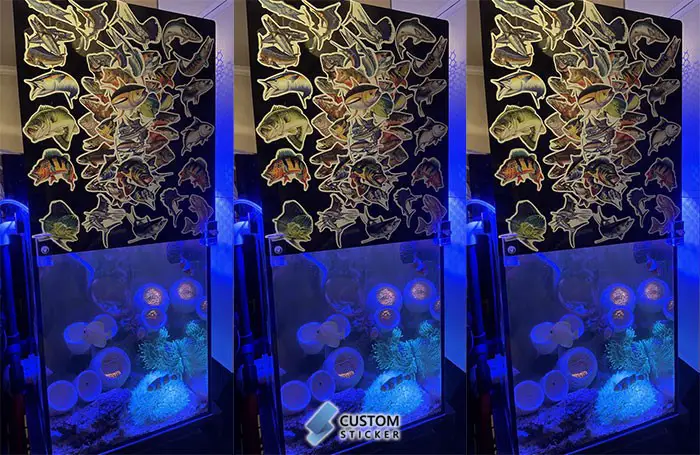
Primarily there are a lot of aspects for each type of freshwater fish to take care of like tank size, water sources and amount, treatment of water, the pH level of aquarium water, filtration of water, the temperature of the water, live plants, frequent cleaning of the tank, inner environment of the tank as well as surrounding environment, proper food and feeding, and tank mate.
If you’re ready to adore these loving pets, then it’s your turn to choose from hundreds of freshwater aquarium fish species available in the market for adding to your aquarium (for example, to a versatile 20-gallon fish tank). As a beginner you should look for the species that suit the ambient temperature of your location, peaceful in nature, non-fussy, requires fewer water changes, and of course easy to maintain.
Here is the list of the 25 best freshwater aquarium fish to help you out.
1. Longfin Zebra Danio (Danio Rerio)

This member of the Cyprinidae family lives up to 5 years and grows up to a max of 3 inches in the home aquarium. Longfin Zebra Danio is available in Blue, Purple, White, and Yellow. Being native to the Ganges region in Eastern India, Longfin Zebra Danio likes a home aquarium planted well with open, large swimming areas.
Longfin Zebra Danio is usually of a peaceful temperament making it a popular choice among aquarists. Therefore keeping them with equal-minded fishes in small-size schools would be best for them. Being omnivores by nature, they eat just anything from high-quality flakes to frozen foods along with other diets.
Male Longfin Zebra Danios are generally found in more torpedo shapes compared to females with a more massive belly.
2. Jack Dempsey (Rocio octofasciata)
It is large freshwater aquarium fish with a striking appearance and attractive mannerism from the cichlid family. The lifespan of Jack Dempsey is 5-7 years, and it grows up to 8 inches. It is native to Guatemala and Honduras.

Jack Dempsey is an aggressive territorial fish with strong facial features compared with the famous 1920s boxer Jack Dempsey. It might prove to be destructive in the aquarium. Therefore, it is recommended to arrange plenty of hiding places keep a clay pot or cave-like structure, or use top freshwater fishing reels on its side as it prefers and that also works well with this fish.
This hearty eater usually accepts flake, vegetable food, and a wide variety of lifelike eating worms, insects, crustaceans, and other fish.
3. Neon Tetra (Paracheirodon innesi)

This small-size freshwater fish is known for its dazzling colors and energetic behavior. Green Neon Tetra is considered as the most popular fish amongst fishkeepers. It is easy to take care of Neon Tetra and often recommended as one of the first fish to beginner aquarists. Native to South America, Neon Tetra belongs to the Characidae family.
This peaceful community fish is best to be kept in a small school of 3 to 6 members. Its size is approx. 1 to 1.5 inches and can live up to 10 years. This omnivore accepts most foods like worms, shrimp, brine, insects, and also plants.
4. Bettas (Bettasplendens)
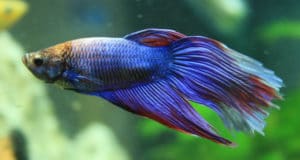
The majority of beginner aquarists choose this viral, vibrantly colorful freshwater fish for their hassle-free maintenance and its aquarium does not even require any filters or heaters. They are easy to take care of and can be kept in small aquariums with other fish species safely. Bettas belong to the Gourami family and are highly territorial.
Bettas usually live 2 – 3 years, but it can extend further in some cases. They grow to the max. 3 inches in size. It requires an omnivorous diet with high protein and fiber consisting of brine shrimp, dried bloodworms, or daphnia. Male Bettas are very notorious fighters; therefore only a single male Betta should be kept in each tank.
5. Discus fish (Symphysodon aequifasciatus)
It is a very reputed, robust, and social fish from the Cichlidae family, often called the king of freshwater tanks. This graceful fish requires a tank of a minimum 25 gallons size. It can grow up to 8-10 inches and live up to 10 years or more.
The most exciting thing about Discus is that it interacts with you displaying its moods and personalities and even observes your movements.
Some say that Discus is not for beginners, but once you grasp their behavior and habitat conditions thoroughly, it is not an expensive venture. In aquariums, Discus fish requires a high protein diet like flake food, blood worms, pellets, beef heart, and black worms.
6. Corydoras Catfish (Corydoras) 
Corydoras Catfish, popularly called Cory Cats is a hardy fish that is ideal for beginner hobbyists. They have a variety of species and are available in different sizes and colors. This freshwater tank fish is a common feature in every community tank. Although Cory Cats are active bottom dwellers, they are calm and peaceful species, and it’s easy to take care of them.
Their size ranges from 1-2.5 inches in length. The lifespan of this fish can be 5 years or more depending on the suitable conditions.
As regards the diet, you can feed Cory Catfish with fish flakes and pellets. They have a habit of digging tank bottom for leftover foods but that cannot suffice for their diet. Usually, Cory Cats are most comfortable in a school size of two or more with mates preferably of similar types.
7. Oscar Fish (Astronotus ocellatus)

It is the favorable tropical aquarium fish from the cichlid family for home aquariums. This big-sized fish of around 35 cms in length needs a minimum 30 gallons tank for better care. The hassle-free Oscar care also requires clean water with the temperature varying between 74°C to 81°C to strengthen their immune system and prevent many diseases.
Native to South America, Oscar fish is generally peaceful, holds the personality, and quick in recognizing strangers. They live up to 10 years. Though it likes live food but eats flakes when young. Sometimes they also eat tank mates of smaller size. They prefer a tank with rock ledges, and live plants do not last long in their tank due to their habit of digging.
8. Guppi (Poecilia reticulata)

Guppies are tropical aquarium fish that are most widely distributed in the world. It is one of the most renowned freshwater fish species for the aquarium as it is nice, active, breeds easily, and not demanding in case of diet. These are from the Poeciliidae family. The lifespan of Guppy is about 2 years on average but can stretch to 3 years in the right tank conditions.
The ideal water temperature for them is 50F – 84F (10-29C), but the temperature should be kept consistent which can be achieved by using the best aquarium chiller. They have an elongated body with flat sides of 0.6–1.4 inches long in the case of males, and for females, they are 1.2–2.4 inches long.
Guppies are easy to feed and gladly accept flakes, pellets, and other artificial food. These are peaceful and friendly to tank mates, but they will eat its juveniles.
9. Platy (Poecilia)

The small yet active Platies are very famous because it’s effortless to take care of them and comes in every color you can imagine. The Poecilia family has around 170 species of varied, colorful fishes. They are very peaceful and great community lovers to go well along swordtails, mollies, and guppies. They carry eggs inside the body and spawn ready-to-swim entirely formed juveniles similar to them.
The size of the fish is 1.5-2.5 inches and females are usually larger than males. They live for about 3-4 years. Platies are omnivorous, but apart from meats, they need much herbivorous food and preferably a good mix of proteins and a plant-based diet.
10. Swordtails (Xiphophorous hellerii)
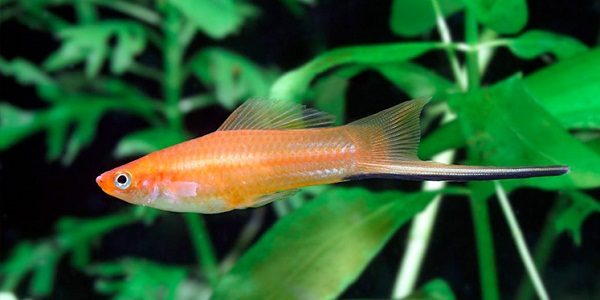
Swordtails are very hardy fish from the Poeciliidae family which makes them very famous spread tank fish and a perfect freshwater species for the beginner aquarist. They have a slightly bulkier body similar to the shape of platy or guppy with a sword-shaped extension of the fin.
Swordtails are available in different color variations. The size of Swordtail may be quite large about 4 to 5 inches long and its lifespan is about 3-5 years. They are quite peaceful in nature but lively and prefer swimming in loose schools of groups.
However, every swordtail has its own temperament either timid and shy or aggressive and blusterous. The diet for swordtail fish should be diversified consisting of artificial, live, or frozen food but must contain vegetable food like fish food flakes with vegetable supplements.
11. Harlequin rasbora (Trigonostigma heteromorpha)

This small, magnificent fish will be a good tank mate for each of the aquarium fish mentioned above. This fish is popular among aquarists for its small size, good temperament and on top of that, it is not demanding. It grows up to 2 inches in length, and the lifespan is about 3-4 years. There is a black spot on its brightly colored body that goes well with its name.
Harlequin rasbora likes swimming and needs a lot of space, so it’s better to keep them in a school in a spacious tank. They are a very peaceful one and can be maintained with fish like tetra, gourami, and betta as long as they are not large and a predator.
It accepts a variety of food except for any large-grained food that is hard for them to swallow. The fishes always stay together in the school, and a large school looks fabulous making the aquarium vibrant and vivid with their graceful movement.
12. Bolivian ram (Mikrogeophagus altispinosus)

It is the correct choice for planted community tanks as maintaining them is very easy. This peaceful, calm and good-tempered cichlid species is quite hardy and lives successfully in a standard fish tank. You may find them a little more aggressive, but they are more like to scare other fish rather than attacking or hurting them.
They are just fine living as a single fish, and also a group of 6-8 species of its kind fits them better. The size ranges from 2 to 5.4 inches. The lifespan is up to 6 years. They are omnivorous and eat all types of live and frozen food like Bloodworm, daphnia, tubifex, and artificial food.
13. White Cloud Mountain Minnow (Tanichthys albonubes)
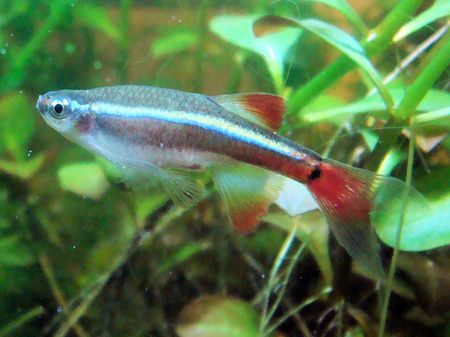
It’s an ideal fish for aquarists who have just gathered knowledge about aquarium husbandry. This very small fish is only 2.5-3 cm in size and absolutely not demanding.
Brightly colored, White Cloud Mountain Minnow is not aggressive and breeds easily. It doesn’t even attack its juveniles. It may live about 3 years if you take good care of them.
The fish prefers middle water layers, and it likes swimming in a school. White Cloud Mountain Minnow manages well in cold water and, therefore, is kept in a pond in the yard in summer by pet lovers.
Being a micro-predator, it feeds on worms, small insects, crustaceans, and other varieties of zooplankton. They like small schools of a minimum of 6 species.
14. Sailfin Molly (Poecilia latipinna)

These are stunning livebearers that originated from southern and central parts of the US. Mollies can live in either salt or freshwater and love to dwell in densely planted aquariums with proper illumination. They like to feed on algae but you can also feed them with flakes, boiled spinach or other fish food specially meant for them.
Mollies can live in both freshwaters as well as saltwater, depending on the way they are acclimatized. These fish require a well-lit tank with plenty of live plants. Mollies are never aggressive towards other tank mates.
Although there are various types of mollies, the most common freshwater fish type is the small finned mollies. Mollies are the easiest variety to breed as they are not choosy during breeding and breed with any kind of molly. The recommended temperature for mollies is 75-80 degrees Fahrenheit. Mollies are considered mid-level swimmers, and it’s better to decorate with plants that help them to hide.
15. Plecostomus (Hypostomus plecostomus)

These are tropical aquarium fish belonging to the Loricariidae family. There are around 150 varieties of Plecostomus, commonly called plecos, which range from peaceful to aggressive varieties. The most common type of catfish is the armored one that grows up to 24 inches and has a lifespan of 10-15 years.
However, beginners can opt for smaller plecos that can be accommodated in a tank size of 10 gallons. They are nocturnal inhabit. The majority of plecos are brown in color, and their body coloration depends on the environment.
Plecos are mostly from South America and also found to exist in both salt and freshwaters. Please keep in mind that plecos can grow from 2-4 inches to a large size very quickly.
WARNING FIRESTICK USERS
YOUR INFORMATION IS EXPOSED
Your location is:
Your current IP address is: 2001:4455:2f7:b700:f880:7bad:b46b:1768
You can stream and download anonymously through your PC, Mac, Android, and iPhone through IP Vanish.
HIDE ME NOW
gdfg
Get 3-Months Free, 30-Day Money Back Guarantee
16. Kuhli Loach (Pangio kuhlii)

Kuhli loach is the most unusual fish, and even an inexperienced aquarist can keep them easily. Being close to true loaches family it resembles a small snake. However, the fish is not harmful at all, rather quite enduring. It is a peaceful ground species that are fond of hiding in the daytime but are more active at night. However, if they are kept with other fish, they become active in the daytime even for food rivalry. It will grow about 4-5 inches in length and live up to 10 years.
They are a euryphagous fish, and Omnivorous bottom feeder, therefore, eats all types of live and frozen food like pellet, different tablets, granules, brine shrimp, blood worm, tubifex, daphnia, and others finding or digging from the bottom of the tank. Thus they are excellent tank cleaners. This fish prefers a school of 5-6 fishes.
17. GloFish (Danio rerio)
This beautiful fluorescent fish, available in various neon colors like red, orange, green, purple, blue and others, are unique. These are genetically modified zebra danio and bred initially to help detect the environmental pollutants. These are safe for the environment and become wonderful pets for new aquarists as well as experienced enthusiasts.
GloFish can grow up to 2 inches in length, and their lifespan is 2 – 4 years but sometimes extends up to 5 years. These can go well with other danios, tetra, angelfish, barbs, and other freshwater fish species that are not big enough to eat them up. They eat worms, insect larvae, flakes mixed with thawed brine shrimp, and small crustaceans. They are peaceful and happy in a group of six or more.
18. Goldfish (Carassius auratus)

Goldfish is a wonderful freshwater variety for both beginner and seasoned aquarium enthusiasts. They are comfortable in a fish tank with 40 gallons capacity and can attain a maximum size of 18 inches. The most suitable temperature for keeping goldfish is 65-72 degrees Fahrenheit.
Goldfish generally prefer aquatic plants, insects, larvae, crustaceans, and other smaller fishes. They can be fed every two weeks, that’s why they make great pets for travelers.
They have a shiny silver or blue combination on their bodies. Goldfish tend to become aggressive and might injure each other during the breeding season. They get along well with tetras, discus, guppies, and female rainbow fish.
You must change the tank environment periodically and keep it clean. You may feed them bread, cracker, biscuit crumbs, rice, potato, peas, carrot, oranges, and zucchini. But make sure you don’t overfeed your goldfish.
19. Pearl Gourami (Trichopodus leerii)
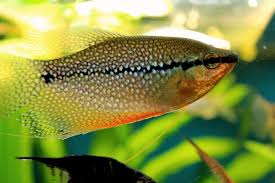
Pearl gourami is a beautiful freshwater fish with white spots across its body and delicate fins. They demand mid-level care and are of peaceful temperament. They grow up to 4-5 inches in length and live up to 5 years. They prefer living in tanks that are heavily planted. Pearl gourami requires a minimum of 30 gallons of water while in an aquarium.
These beautiful fishes are covered in white pearl-like spots thereby giving them a distinguished appearance. They are acquainted with living in slow-moving freshwater in Asia. They thrive best in tanks having a temperature between 77-82 degrees Fahrenheit with hardness ranging from 5-15 dh.
Pearl gouramis are peaceful fishes like pearl danios or neon tetras. They are omnivorous by habit and live on larvae, small insects, eggs, and algae. They suffer from a disease called fin rot which results in decay and discoloration.
20. Angelfish (Pterophyllum)
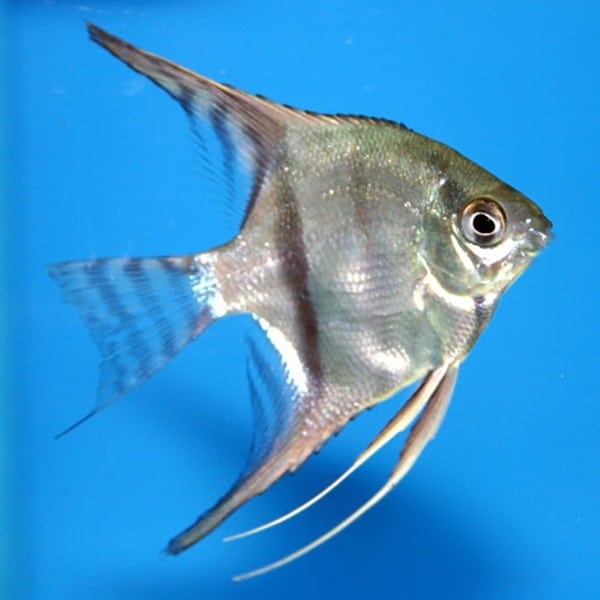
Angelfish is a freshwater variety that is originally native to South America. Carnivorous by nature, Angelfish needs proper for its overall growth and wellbeing. So feeding it with flakes, pellets, shrimps, daphnia, etc. can work best for them. Angelfishes can grow up to 6 inches provided you take good care of them. In some cases, they can even grow to a size of 10 inches if kept in bigger tanks.
Angelfish is considered community fish and prefers to grow with other tropical species. They must be kept in the cleanest, large-sized tanks having proper filtration. Right water conditions can lessen the stress of these fishes and keep them healthier, happier. Angelfish prefer a temperature of 80 degrees Fahrenheit for spawning and the average pH of water for the same should remain 6.5 to 6.9.
The females prefer to deposit eggs near neat rows on the submerged slate which remains leaned against the wall in aquariums. Both male and female species look identical. They are a very rewarding variety for first-time hobbyists.
21. Killifish (Austrolebias affinis)

Killifish is one of the vibrantly colored and beautifully patterned freshwater aquarium fish. The concern level for keeping these fishes depends on easy to difficult and varies according to species. They are vividly colored and have a lifespan of 3 months to five years.
Carnivorous by nature, Killifish grows up to 2.9 cms in length in a tank with a minimum of 20 gallons of water. The tank water should be 72- 75 degrees Fahrenheit with 120-160 ppm hardness. The tank set-up is very simple with a bare floor, having a minimal light setting and also a sponge filter.
They are slender and pike-shaped which makes them great swimmers. With larger dorsal and anal fins, Killifish are good community fish and blend well with other peaceful species like neon tetras and rummy nose tetras. They inhabit a large number of places including saltwater and also tank water environment.
22. Rainbowfish (Melanotaeniidae)

Rainbowfish is native to Papua New Guinea, Indonesia, and Australia. They thrive in lakes, rivers, and swamps. They thrive well in aquariums where the temperature of water remains 74-78 degree Fahrenheit and have at least 30 gallons of water. In case your aquarium is kept below 74 degrees Fahrenheit, then you must use Aqueon aquarium for increasing the temperature.
Rainbowfish are peaceful and active behavior-wise and can be kept well with larger tetras, rasboras, catfish danios, and other non-aggressive cichlids. The males have vibrant colors and vie for the females during breeding. However, breeding of these fish is a difficult task.
The rainbowfish feed on color flakes, aquean tropical flakes, spirulina flakes, and also betta treat. You must feed the fish whatever they can eat in 2 minutes. Rotating the fish food can be best for them.
23. Cherry barb (Puntius titteya)
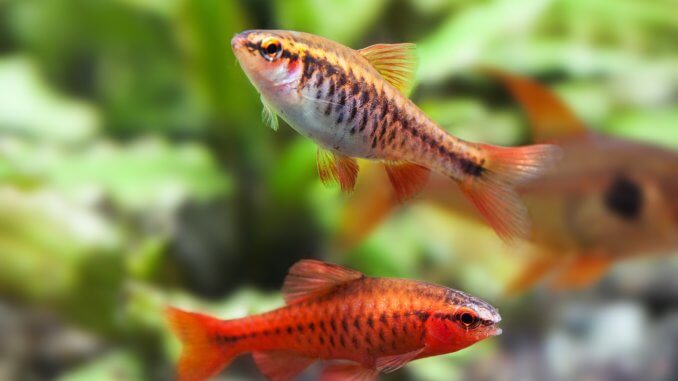
Cherry barb is found in the freshwaters of Sri Lanka and other South West areas. They live in shadowed areas surrounding the streams and small rivers. They thrive comfortably where the water temperature is 23 to 27 degrees Celsius with pH 6 to 8. These are small fishes that are 1 to 2 inches in length and grow up to 1.8 centimeters.
While male cherry barbs have brown-green, reddish, and brown-red color combinations, the female counterparts are found in yellow-gray and brown-red. Cherry barbs are omnivorous by nature and have a lifespan of 4-5 years.
They mostly swim in the middle and bottom layers of the water. Although peaceful and calm by behavior, the males fight with each other by dancing in front of their rivals. Small cherry barbs are easy prey for predator fish so you should keep them with other community fishes like harlequin rasbora, neon tetra, betta, cardinal tetra, neon tetra, and catfish.
24. Kribensis (Pelvicachromis pulcher)
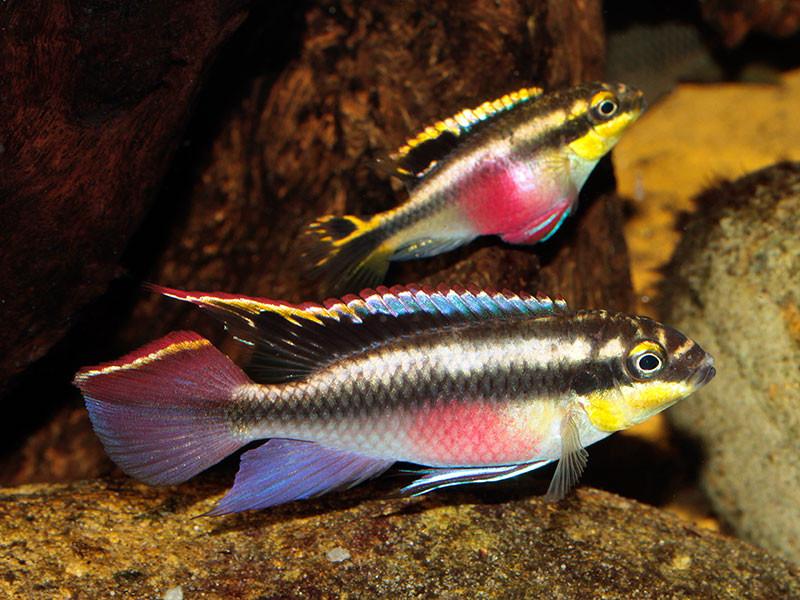
They originate from Africa and grow up to 3-4 inches in length. Kribensis thrive well in an aquarium with a minimum of 20 gallons of water. They are peaceful by behavior and have a lifespan of 5 years. These bottom dwellers are comfortable in aquariums where the water temperature is 75- 77 degree Fahrenheit with pH 6.4. The hardness of water should remain 8-12 dGH.
Kribensis are colorful fish having color morphs like green, red, yellow, and blue. The adult males grow up to 4 inches while the females grow up to 3 inches. They are kept in community tanks where they nib the fins of slow-moving fish like angels. You may provide caves where they can do the spawning. They are omnivorous in nature and thus feed on all types of food including daphnia, shrimp, flake, mosquito larvae, and bloodworm.
25. Bristlenose Pleco (Ancistrus)

This freshwater aquarium fish comes in a number of colors including black, brown, yellow, etc., and has colored body spots throughout. As the name suggests, Bristlenose usually possesses a flat body with bony plates that appear like tentacles on maturity.
Bristlenose plecos are peaceful species and get along with other tank mates. They are a hardy type and hence easy for the first-time hobbyists to keep. They have a bony armor. They prefer a water temperature of 15 to 27 degrees Celsius with pH 6.5 to 7.5.
The diet for Bristlenose pleco consists of 85% protein and 15% plant matter. If you’re looking for an algae eater, this fish would be the best choice.
Summary
Freshwater Fishes are hugely popular amongst aquarists as they are very beautiful to look at thereby increasing the ambiance of the living space as well as the aquarium. Most aquarists want to add fishes that are easy to maintain and are compatible with other types of fishes.
In the list of best freshwater fish discussed above, the behavior, appearance, dietary preference and life span are discussed in great detail. Make a choice after doing proper research from the detailed guide and as per your aquarium requirement.
